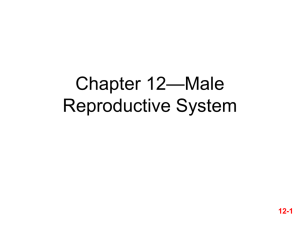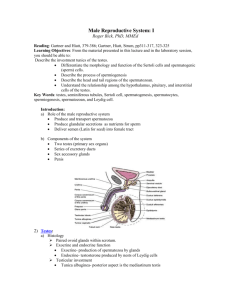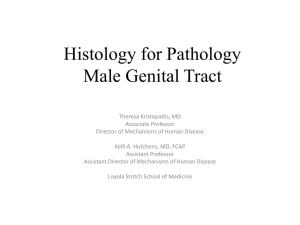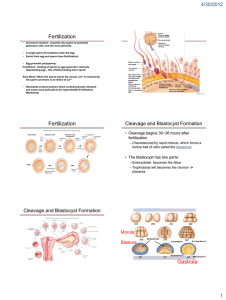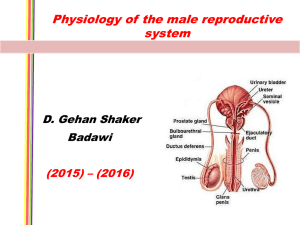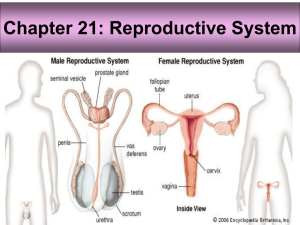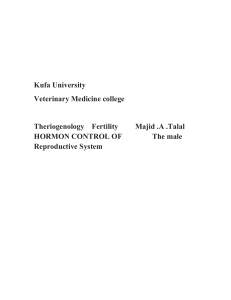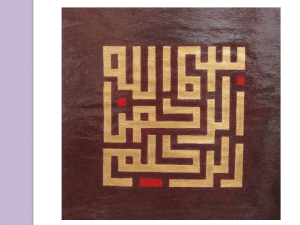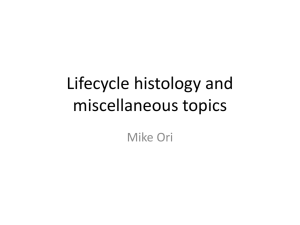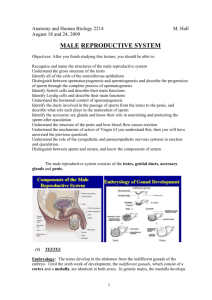lecture 14
advertisement
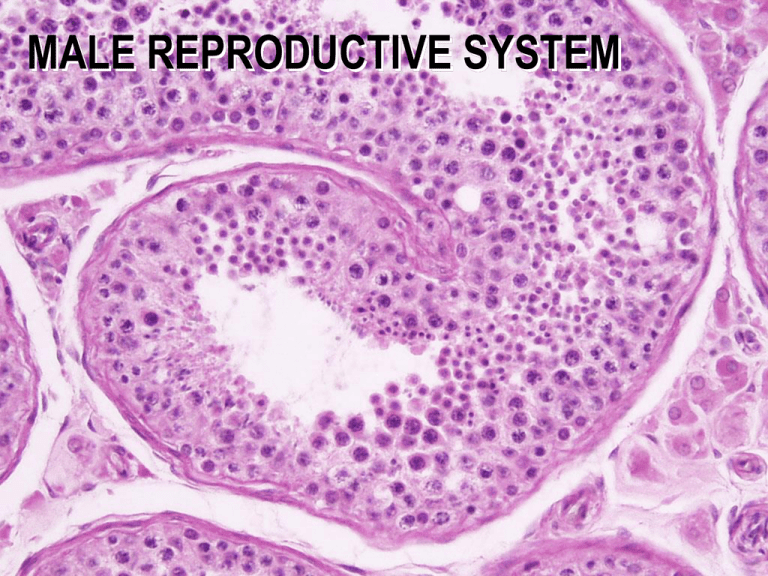
MALE REPRODUCTIVE SYSTEM MALE REPRODUCTIVE SYSTEM TESTES EPIDIDYMIS VAS DEFERENS SEMINAL VESICLES PROSTATE BULBOURETHRAL GLANDS URETHRA TESTIS H&E SEMINIFEROUS TUBULES TESTIS H&E SEMINIFEROUS TUBULES SEMINIFEROUS TUBULES INTERSTITIAL CONN. TISSUE TESTIS H&E SEMINIFEROUS TUBULES SEMINIFEROUS TUBULES INTERSTITIAL CONN. TISSUE MALE REPRODUCTIVE SYSTEM SPERMATOGENESIS SPERMATOGONIA 1º SPERMATOCYTE 2º SPERMATOCYTE SPERMATIDS SPERMATIDS 2º SPERMATOCYTE 1º SPERMATOCYTE SERTOLI CELLS: - columnar with adjoining lateral processes - extend from basal lamina to lumen - Sertoli-Sertoli junctions divide seminiferous tubules into basal and adluminal compartments SERTOLI CELLS SPERMATOGONIA MALE REPRODUCTIVE SYSTEM SPERMATOGENESIS THREE PHASES: (1) Spermatogonial Phase (Mitosis) - spermatogonia proliferate by mitotic divisions to provide stem cells and cells which will proceed through spermatogenesis (1º spermatocytes) (2) Spermatocyte Phase (Meiosis) - diploid cells (2n) created in spermatogonial phase give rise to haploid cells (1n) - Meiosis I (reduction division) & Meiosis II (equatorial division) - 1º spermatocytes enter Meiosis I to form 2º spermatocytes which then enter Meiosis II and result in spermatids (3) Spermatid Phase (Spermiogenesis) - spermatid differentiation into spermatazoa SEMINIFEROUS TUBULES MALE REPRODUCTIVE SYSTEM HORMONAL REGULATION OF MALE REPRODUCTIVE FUNCTION HYPOTHALAMUS REGULATES ACTIVITY OF ANTERIOR PITUITARY (ADENOHYPOPHYSIS) ADENOHYPOPHYSIS SYNTHESIZES HORMONES (LH and FSH) THAT MODULATE ACTIVITY OF SERTOLI AND LEYDIG CELLS Luteinizing Hormone (LH): stimulates testosterone production by Leydig cells Follicle Stimulating Hormone (FSH): stimulates production of sperm in conjunction with testosterone by regulating activity of Sertoli cells SERTOLI CELLS STIMULATED BY FSH AND TESTOSTERONE RELEASE ANDROGEN BINDING PROTEIN WHICH BINDS TESTOSTERONE; THEREBY INCREASING TESTOSTERONE CONCENTRATION WITHIN THE SEMINIFEROUS TUBULES AND STIMULATING SPERMATOGENESIS EFFERENT DUCTULES EPIDIDYMIS EPIDIDYMIS Functions of Leydig Cells • Production of High Levels of Testosterone ( 5mg/day in adults ) • Direct Production of Estradiol • Production of Dihydrotestosterone (DHT) • Production of dehydroepiandrosterone (DHEA) and androstenedione • Production of Progesterone and 17a -prog. LKS Functions of Sertoli Cells • Support Production of Spermatozoa • Production of Androgen-Binding Protein Intratesticularly (TeBG) • Form Blood-Testes Barrier • Produce Inhibin • Produce Seminiferous tubule fluid (bathing medium, nutrients, capacitation, motility) LKS End product: special structures • Spermatozoa Structure and Functions in Review Head – Acrosome: – Nucleus: • Midpiece – Centrioles: – Mitochondria: • Tail: flagellum – Microtubules: Figure 26-10: Sperm structure Regulation of Spermatogenesis • GnRH LH Leydig cells testosterone sex charact. • GnRH FSH Sertoli cells spermatoctye maturation • Inhibin feedback – FSH, testosterone – short & long loops
